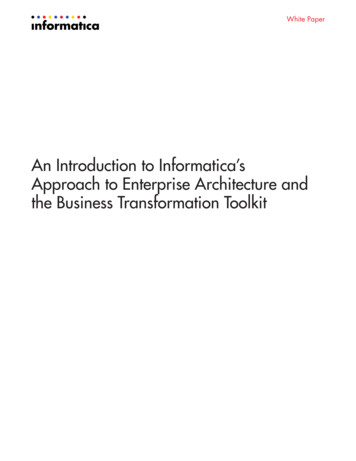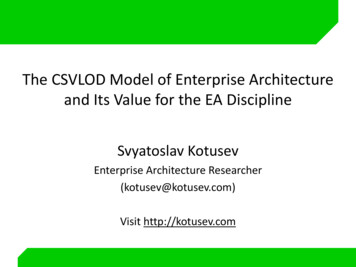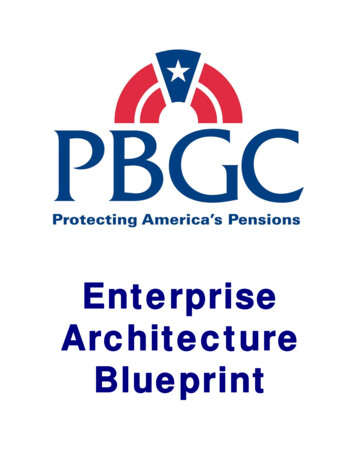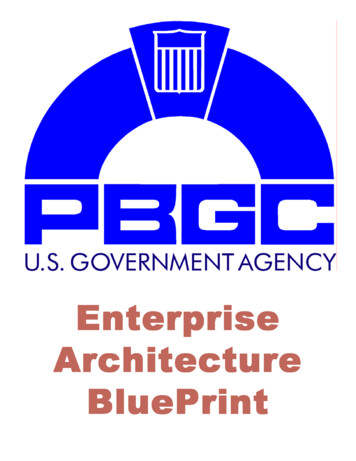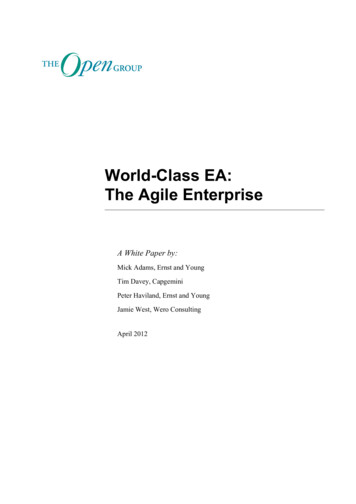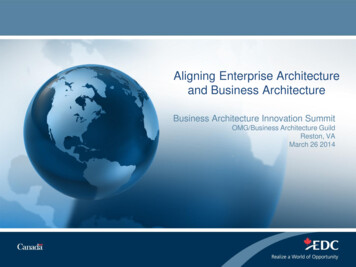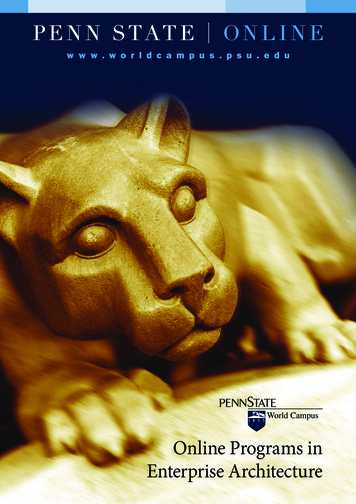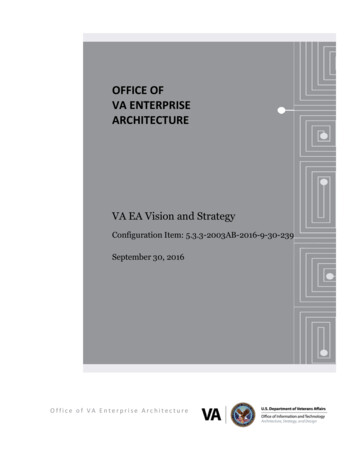
Transcription
OFFICE OFVA ENTERPRISEARCHITECTUREVA EA Vision and StrategyConfiguration Item: 5.3.3-2003AB-2016-9-30-239September 30, 2016Office of VA Enterprise Architecture
VA EA Vision and StrategySeptember 30, 2016Revision HistoryDate of ChangeSeptember 29, 2013September 30, 2016iIndividual Making ChangeVA EA TeamVA EA TeamDescription of ChangeInitial documentTech edits and revision updatesOFFICE OF VA ENTERPRISE ARCHITECTURE
VA EA Vision and StrategySeptember 30, 2016Table of Contents1Executive Summary .12Introduction .32.12.2Vision of the VA EA . 5Principles. 52.2.12.2.22.3VA Global Principles . 6VA EA Guiding Principles . 6Purpose . 63VA EA Goals and Outcomes .84Evolving the VA EA. 114.14.24.34.44.54.64.74.85Governance. 11Principles. 14Method . 14Tools. 17Standards . 18Use . 19Reporting . 21Audit . 21Summary . 23Appendix AAcronyms and Abbreviations. A-1Appendix BTerms and Definitions . B-1Appendix CReferences . C-1Appendix DSupplemental Information on Uses . D-1D1D2D3D4D5Inform Portfolio/Investment Management . D-1Inform Project Management . D-1Support Strategic Planning . D-2Inform Solution Design . D-3Inform IT Acquisition . D-3Appendix ETransformational, Regulatory, Policy, and Directive Drivers . E-1List of FiguresFigure 2-1: VA EA Scope . 4Figure 2-2: Vision for VA EA . 5Figure 3-1: Outcomes/Goals Supported by Use of VA EA . 10Figure 4-1: VA EA Eight Basic Elements . 11Figure 4-2: Governance Structure for VA EA . 12iiOFFICE OF VA ENTERPRISE ARCHITECTURE
VA EA Vision and StrategySeptember 30, 2016Figure 4-3: Conceptual Federated VA EA Environment . 15Figure 4-4: VA EA Build Cycle . 16Figure 4-5: VEAMS Capability Implementation Plan. 17Figure 4-6: EA and VEAMS Maturity Cycle . 18List of TablesTable 3-1: VA EA Goals and Outcomes . 8Table 4-1: VA EA Uses Mapped to VA EA Goals . 20Table 4-2: Potential VA EA Business Reports . 21Table 4-3: EAMMF Stages . 22Table E-1: Architecture Drivers . E-1Table E-2: Business Need Questions Mapped to Strategic Drivers and VA EA Goals . E-3iiiOFFICE OF VA ENTERPRISE ARCHITECTURE
VA EA Vision and Strategy1September 30, 2016Executive SummaryThe Department of Veterans Affairs (VA) is transforming to improve its support to Veterans. Toachieve a level of seamless support for VA, a more efficient and better-integrated enterprise isrequired. The envisioned enterprise creates the alignment of strategic direction, businessoperations, technology, and data, and is methodically designed, aggregated, and managed todeliver the right information to the right place at the right time to support decision makers.At the core of this transformation is the VA Enterprise Architecture (EA). The VA EA is the strategicplanning and management tool that supports operations, execution, and managementaccountability, and equips leadership to execute change across the Department. The VA EAprovides the enterprise-level line-of-sight needed to support informed decision-making.The combination of intent, resources, methodology, and execution aligned through the VA EAenables a VA enterprise that provides a consistent and seamless experience for accessinginformation and delivering improved services to U.S. Veterans and their families.According to The Common Approach to Federal Enterprise Architecture (CAF), the outcomes/goalssupported by effective use of an EA are improved service delivery, functional integration, resourceoptimization, and authoritative reference.1 VA continues to recognize these four outcomes as beingconsistent with meeting VA transformation objectives and adopted them to shape VA EA evolution.VA is also employing a question-based, data-centric approach to provide focus, specificity, andconsistency to its effort to mature the VA EA. This approach has required a fundamental change inthe way VA plans, governs, develops, and implements its enterprise architecture. VA considers theVA EA as the foundation of its VA EA Program and evolves it based on the eight basic elementsidentified in the CAF that must be present in an agency EA program – governance, principles,method, tools, standards, use, reporting, and audit – and the strategic drivers that affect itscontent.To date, substantial work has been accomplished toward achieving the VA EA vision of being theauthoritative reference for the requisite integrated strategic, business, and technology informationused to make informed decisions across the Department.The VA EA has been gaining ground in transitioning to an integrated set of information derived fromindependently developed architectures within VA. These architectures provide quality service forspecific portions of VA. Expanding the integrated information pertinent to Veterans interests acrossorganizational or functional boundaries and presenting a VA “enterprise view” is the continuing taskof the VA EA. Additionally, the VA EA will provide a cohesive set of tools to maximize utilization ofthe integrated information by a wide VA customer base.Crucial to success is the stakeholder. Collaborative engagement is required to define an effectiveand informative VA EA and transition to its useful application. Stakeholders will be involvedthroughout the lifecycle of the architecture: participating in the governance process, applying itsprinciples, and supplying requirements that drive content development. Through strategic planning,investment management, and solution design processes, stakeholders will use the VA EA content to1“The Common Approach to Federal Enterprise Architecture,” Office of Management and Budget, May 2, 2012, 5,https://www.whitehouse.gov/omb/e-gov/FEA.1OFFICE OF VA ENTERPRISE ARCHITECTURE
VA EA Vision and StrategySeptember 30, 2016inform the decisions that will enable VA to achieve its integrated objectives. The VA EA ProgramCommunications Plan will help inform stakeholders about the VA EA and its capabilities.A clear, accepted, and shared strategy for the VA EA will enable VA Administrations and StaffOffices’ efforts to be planned and implemented in a more coordinated and integrated fashion. Thisdocument provides a complete picture of the vision, strategic goals, and steps VA will take toprovide an authoritative information asset base known as the VA EA.2OFFICE OF VA ENTERPRISE ARCHITECTURE
VA EA Vision and Strategy2September 30, 2016IntroductionVA is a large organization with diverse and complex missions. Currently, the VA EA aggregates andfederates information about services and capabilities of the three Veterans Administrations –Veterans Health Administration (VHA), Veterans Benefits Administration (VBA), and NationalCemetery Administration (NCA) – and the Staff Offices. This aggregation provides a holistic view ofVA that is necessary to achieve the integrated objectives of the Department.As VA continues its transformation to improve support to the nation’s Veterans, it must supportand advance the strategic goals and objectives of the Department of Veterans Affairs 2014–2020Strategic Plan. These goals and objectives should directly impact VA EA content so that thearchitecture is useful to decisions made to achieve VA objectives. In other words, the VA EA mustdescribe current and future business and information technology (IT) needs with attention to theVA 2014–2020 Strategic Plan to make better informed decisions. A more detailed description of therelationships between objectives, the questions that can be asked, and how architecture can beused to answer the questions is included in Appendix E: Transformational, Regulatory, Policy, andDirective Drivers.The VA EA is evolving into an efficient and integrated architecture that can support VA strategicgoals and objectives. Aligning strategic direction with operations, technology, and data that ismethodically structured, aggregated, and managed will enable the VA EA to deliver the rightinformation to decision-makers at the right time and enable VA in providing Veterans and theirfamilies a consistent and improved experience for accessing information and services.Only an enterprise-wide architecture can provide an integrated view of strategic,business, and technology domains across all lines of business, services, and systems,which is critical to optimizing mission capabilities and resource utilization. Atpresent, no other management best practice, other than EA, exists that can serve asa context for enterprise-wide planning and decision-making. 2Figure 2-1 provides a conceptual depiction of the scope of the VA EA necessary to support VA in thiseffort. The top layer identifies the types of information: strategic, business, and technical. Themiddle layer depicts how the information is organized and stored within the VA EA. The bottomlayer illustrates some of the potential products (artifacts) from the integrated information andareas where they may be applied.23Ibid., 26.OFFICE OF VA ENTERPRISE ARCHITECTURE
VA EA Vision and StrategySeptember 30, 2016Figure 2-1: VA EA ScopeThe CAF identifies six subarchitecture domains that “delineate the types of analysis and modelingnecessary for an architecture to meet stakeholder requirements.”3 VA has incorporated this domainconcept into the structure of the VA EA for how and what information will be addressed. The datathat is collected and integrated, as well as its presentation, must provide information required fromthe strategic, business, data and information, systems and applications, networks andinfrastructure, and security perspectives to inform VA decision-making.The VA EA responds to several strategic drivers that also affect its content. These drivers can begrouped into three categories: transformational needs, legislative mandates, and policies anddirectives. Transformational needs are business priorities the VA has identified that requireenterprise-wide changes in underlying strategy and processes. Legislative mandates establish thestatutory basis for building and using the VA EA. Lastly, policies and directives provide guidance inseveral areas ranging from EA frameworks to methods for assessing EA maturity. All these driverswill be revisited continuously during the evolution of the VA EA. Appendix E: Transformational,Regulatory, Policy, and Directive Drivers lists several of the strategic plans, legislative mandates, andpolicies that affect VA EA.34Ibid.OFFICE OF VA ENTERPRISE ARCHITECTURE
VA EA Vision and StrategySeptember 30, 20162.1 Vision of the VA EAThe vision of the VA EA is to be the authoritative reference for the requisite integrated strategic,business, and technology information used to make informed decisions across VA. It provides anenterprise view of the VA to those who make decisions that effect change within VA business or ITenvironments (see Figure 2-2). This vision will be achieved through an ongoing, collaborative effortbetween VA’s Administrations and Staff Offices supporting the delivery of benefits andmanagement of the Department. Together, these organizations document the current and desiredrelationships among business processes and IT, and develop business rules, standards, and decisionmaking criteria that support the transition to the desired state. By using VA EA-enablingcomponents such as a development environment and tools, analyses, and data management, thisinformation is integrated and federated into an enterprise view in various formats for VA use.Figure 2-2: Vision for VA EA2.2 PrinciplesAll VA IT investments are subject to six VA Global Principles that support transformation andimprove IT support for the VA mission. Additionally, development and use of the VA EA is guided bysix outcome-based principles applied within the VA EA End-to-End (E2E) Process, which isdocumented in the VA EA Architecture Development Methodology (ADM). The VA Global Principlesapply equally to the development and use of the VA EA. The VA EA Guiding Principles (seeSection 2.2.2) support the VA Global Principles (see Section 2.2.1).5OFFICE OF VA ENTERPRISE ARCHITECTURE
VA EA Vision and StrategySeptember 30, 20162.2.1 VA Global Principles1. Mission Alignment – VA processes, information, and systems are conceived, designed,operated, and managed to address the Veteran-centric mission needs of the Department.2. Asset Visibility and Accessibility – VA Service, Data, and Application Assets are visible,accessible, available, understandable, and trusted by all authorized users (includingunanticipated users).3. Data Interoperability – VA Information is made interoperable through data standardization,including the identification, designation, and utilization of authoritative sources.4. Infrastructure Interoperability – VA IT Infrastructure is made interoperable throughdefinition and enforcement of standards, interface profiles, and implementation guidance.5. Information Security – VA provides a secure network, IT environment, and security controlsfor the storage and collaborative sharing of information assets (e.g., information, services)with Veterans, their families, and other partners. These include (among others) Federalagencies, third-party service providers, academia, researchers, and businesses.6. Enterprise Services – VA solutions are built as common services using enterprise standardswhere similar business use cases exist.2.2.2 VA EA Guiding Principles1. Question Based – Questions are created based on business needs with the intent that theiranswers will indicate that the business needs were met. Complex needs are decomposedinto a hierarchy of questions that are used to plan multiple VA EA releases to meet theoriginal needs. Entities and their relationships that drive changes to the VA EA are identifiedfor each question. These entities can span the strategic, business, data, systems,infrastructure, and security domains.2. Enterprise Perspective – Through integration and federation of Administration- and StaffOffice-approved data, the VA EA depicts the relationships among VA’s various parts. Entitiesacross VA align and adhere to a common language and structure through the VA EnterpriseArchitecture Repository (VEAR) Logical Data Model and are related to other entities that allalign to a business need. This enables business users to see their particular needs within thecontext of the larger VA and encourages reuse.3. Tool Agnostic – Architecture information is shareable across VA at the enterprise, segment,and solution levels independent of the modeling tools with which it was created.2.3 PurposeThe purpose of this document is to provide a description of the future direction of the VA EA.4 Thisdescription includes the supporting principles that guide and constrain VA EA development anduses, and the goals and outcomes that drive content based on VA’s changing priorities.4Other lower-level details describing the tactical operations for VA EA governance, configuration management,value and performance measures/metrics (Enterprise Architecture Management Maturity Framework [EAMMF])to gauge effectiveness of the VA EA will be contained in other documents (e.g., Configuration Management Plan,ADM, VA EA Architecture Style Guide [ASG]).6OFFICE OF VA ENTERPRISE ARCHITECTURE
VA EA Vision and StrategySeptember 30, 2016Stakeholders should use this document to gain an overall awareness of the high-level, enterprisewide guiding principles for the VA EA. It can also be used as the basis for developing specificimplementation activities to support the VA EA.7OFFICE OF VA ENTERPRISE ARCHITECTURE
VA EA Vision and Strategy3September 30, 2016VA EA Goals and OutcomesCAF lists the following as the primary outcomes enabled by developing and using EA: Service deliveryFunctional integrationResource optimizationAuthoritative reference5VA recognizes the four outcomes proposed by CAF as consistent with addressing the driversidentified in Appendix E: Transformational, Regulatory, Policy, and Directive Drivers, and hasadopted them as goals to evolve the VA EA. These drivers consist of transformational needs,legislative mandates, and policies and directives. This recognition and adoption enables the VA EAto serve as a value-added enabler of these outcomes.Much time has been spent establishing and understanding the current environment and itscomponents from an architectural perspective. Although this work continues, attention must beturned to the VA’s vision and how the VA EA can describe it in terms understandable to the entireDepartment. To achieve transformation, additional focus on the target or future architecture for VAis required. Analyzing a target architecture against VA’s current baseline enables development of atransition plan to establish and track progress toward the target state.Table 3-1 describes VA EA goals and outcomes, which are consistent with attaining the VA EA visionand meeting VA transformation objectives.Table 3-1: VA EA Goals and OutcomesGoal 1: Support Improved Service DeliveryVA has been moving to an IT shared services strategy that results in a more secure, robust, reliable, rapidlyscalable, efficient, and interoperable infrastructure to support seamless service delivery. The VA EA willidentify the needed connectivity and computing capabilities that allow all users to access, share, and act oninformation required to accomplish the mission.An example of VA EA support is identifying all the capabilities mapped to a function that contains a service,their current interfaces, data they process, and the opportunity to improve service outcomes by adding anew interface.Goal 2: Support Functional Integration/InteroperabilityVA data, systems, technology, and IT services are contributors to capabilities that provide benefits andservices. Interoperability within and across these mechanisms is paramount to the success of VA. The VAEA must capture both the context (strategic, business, and technology) for the way they “fit within theenterprise” and the requisite standards that enable interoperability.An example of VA EA support is to assist in establishing the metadata and standards for common Veterandata.58Common Approach to Federal Enterprise Architecture, 5.OFFICE OF VA ENTERPRISE ARCHITECTURE
VA EA Vision and StrategySeptember 30, 2016Goal 3: Facilitate Resource OptimizationWith the current Federal Government trend of decreasing budgets and mandating and improving servicedelivery, agencies are forced to find ways to do more with less. This means that government entities mustimplement leading practices for planning and investment management. The VA EA’s ability to discovercurrent resources (people, data, and technology) and then assist in determining where they and theirfunding can best be used is critical to VA’s ability to optimize its resources.An example of VA EA support is identification of all the capabilities that map to a business function andthen working with business stakeholders to identify redundancies that can be eliminated.Goal 4: Serve as Authoritative ReferenceThe value of information made available to VA’s decision-makers is directly proportional to the quality ofthe information and the degree of trust the decision-makers have in it. For the VA EA to achieve its vision,it must be viewed as an authoritative reference for the information it makes available to its end users. Itmust also contain information on and enable discovery of information assurance requirements andsecurity controls mandated by appropriate Federal guidance.An example of VA EA support is engagement of the Administrations in integrating their business functionsinto the VA Business Reference Model (BRM) so that the VA BRM can be used as a reference for commonbusiness functions across the Department.The VA EA Team understands that the key to achieving these outcomes is to have the rightinformation available, accessible, visible, and understandable to the appropriate decision-makers.Therefore, the Team has adopted a question-based, data-centric approach to focus its efforts fordeveloping and using the VA EA.This approach is founded on asking the right questions (i.e., the questions most relevant to VAbusiness and IT stakeholders for their specific business need) and identifying the data required toanswer the questions. This data represents the information that must be captured within andvisualized by the VA EA.Figure 3-1 presents the VA EA strategic goals and outcomes, and some of the associated questionsthat can be answered to achieve the goals. These questions are a sampling and not an exhaustivelist.9OFFICE OF VA ENTERPRISE ARCHITECTURE
VA EA Vision and StrategySeptember 30, 2016Figure 3-1: Outcomes/Goals Supported by Use of VA EAWhen the VA EA E2E Process documented in the VA EA ADM is initiated in response to a businessneed, questions are drawn from Figure 3-1; additional ones are created as necessary to fullyaddress the business need. New questions are mapped to the VA EA Goals and the appropriatedriver as indicated in Appendix E: Transformational, Regulatory, Policy, and Directive Drivers.Appendix E provides the approach for mapping questions to strategic drivers and VA EA Goals as anaid in prioritizing requirements.10OFFICE OF VA ENTERPRISE ARCHITECTURE
VA EA Vision and Strategy4September 30, 2016Evolving the VA EAFor the VA EA to achieve its vision, it must mature internally in several areas while improving itsoutwardly focused value to the Administration and Staff Office users of its information. Accordingto the CAF, eight basic elements compose an EA program. They are depicted in Figure 4-1.Figure 4-1: VA EA Eight Basic ElementsThe following sections describe what VA is doing to evolve the VA EA Program in each element.4.1 GovernanceGovernance comprises the planning, decision-making, and oversight processes used by oversightentities that will determine how the VA EA is developed, verified, versioned, used, and sustained.VA has identified several entities that must interact to enable the VA EA to support achievement ofVA transformational objectives. Figure 4-2 depicts the entities and their relationships.11OFFICE OF VA ENTERPRISE ARCHITECTURE
VA EA Vision and StrategySeptember 30, 2016Figure 4-2: Governance Structure for VA EAAs mentioned previously herein, the VA EA should provide an enterprise-wide view to those whomake decisions that effect change within the VA business and/or IT environments. VA EA servicesand products support the Department’s business and operational visions, missions, and goals andprovide information useful to VA’s Capital Planning and Investment Control (CPIC) processes. Theyalso help ensure alignment of technologies with strategic priorities and the elimination ofredundancy, thus providing invaluable support to portfolio management.The VA EA is under the leadership of the VA Chief Enterprise Architect who: 12Leads the program on behalf of the Chief Information Officer (CIO) and serves as an advisorto the CIO and VA leadershipCollaborates with IT and business leaders to identify and establish priorities andmethodologies for EA development and use, and identifies and integrates informationassets from across the Department with the VA EAOwns the overall framework for the VA EA, including standards, policies, and rules for theEA development methodology, tools, and repository that ensures:– The integrity of EA products and their consistent evolution and alignment in supportof VA’s strategic direction– Establishment and maintenance of rules and standards to be implemented insupport of VA EA developmentOFFICE OF VA ENTERPRISE ARCHITECTURE
VA EA Vision and StrategySeptember 30, 2016Information required to support the aforementioned VA decision processes isvisible, accessible, and understandable through the EAProvides the best possible information and guidance to IT projects and stakeholders, andassists in ensuring that programs, initiatives, and supporting systems development effortsare properly aligned with VA strategic goals and objectives and program/business unitrequirements.6– The Chief Enterprise Architect also maintains the VEAR, ensuring EA tools and information requiredto support analyses and VA decision processes are visible, available, accessible, and understandableto stakeholders across the Department.VA EA is a federated decision support tool established to meet the needs of the enterprise andfacilitate the accomplishment of the Department and CIO’s strategic agendas. Thus, the governanceof the VA EA must involve stakeholders and business decision-makers from across VA.Representatives who participate in governance forums must have the authority to represent theirrespective organization’s interests and make decisions on their organization’s behalf.Currently, two VA EA governance bodies exist: Business Architecture Working Group (BAWG) is the successor to both the EnterpriseArchitecture Council and Enterprise Architecture Working Group. As a working-level entity,it assists in the tactical execution of the VA EA development lifecycle. The BAWG is led bythe Director of EA; members are functional architects, planners, process managers, andother business representatives from across VA. It serves as a forum to communicateenterprise data and information needs, and outlines the requisite actions to collect thatdata and make it visible, accessible, and understandable.Technical Architecture Working Group (TAWG) provides a forum to identify, communicate,develop, and govern technical requirements and policies related to hardware, software, andinfrastructure that support VA enterprise needs. The TAWG, chaired by the VA EA LeadTechnical Architect (Office of Information and Technology [OI&T]/Architecture, Strategy,and Design/EA), includes members that represent program development, infrastructuredelivery, and sec
ARCHITECTURE VA EA Vision and Strategy Configuration Item: 5.3.3-2003AB-2016-9-30-239 September 30, 2016 . . According to The Common Approach to Federal Enterprise Architecture (CAF), the outcomes/goals supported by effective use of an EA are improved service delivery, functional integration, resource .

